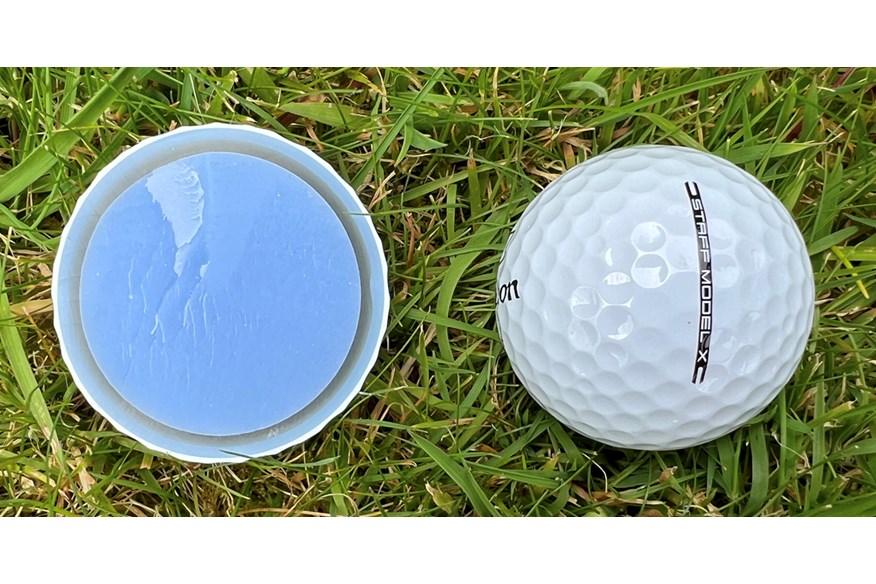Want maximum distance from your swing speed? Then stop playing Titleist and TaylorMade golf balls…
Last updated:
Our robot test has found the longest golf ball at multiple swing speeds – and they’re probably not the models you expected!
I don’t think there’s a golfer on the planet who wouldn’t like more distance off the tee. There’s endless data to show that longer drives equal lower scores and there are few better feelings than bombing a drive miles past your mates’.
There are lots of things you can do to improve your driving distance. Get a custom fitted driver. (If you’re going to do that, you’ll want to see that we tested every golf driver and this was the longest of them all.) Have lessons and work on your technique. Increase your power with a well-planned exercise program. Stretch regularly to improve mobility. Use swing speed training systems like SuperSpeed Golf or The Stack System.
But those all involve a significant investment of time and/or money. What if I told you that you could instantly increase your distance off the tee – just by switching golf ball?
The recent Today’s Golfer robot golf ball test measured and compared 24 leading golf balls across every conceivable performance metric. Among those was distance. The test included hitting balls with driver at 85mph, 100mph, and 115mph, meaning you can choose the data most relevant to your own game. If your speed sits right in between two of those speeds, you could opt for the best-performing ball from either set but, ideally, test the two head-to-head to see which works best for you.

Longest golf ball at 85mph swing speed
The Wilson Staff Model golf ball generated the longest carry distance at this clubhead speed, registering 193.6 yards. That may only be 3.6 yards longer than the average of all balls at this speed, but it’s 8.6 yards longer than the Srixon AD333, the shortest at this speed, which proves that choosing the wrong ball could cost you significant distance.
The Vice Pro Plus (192.4 yards) and Callaway Chrome Tour X (192.1 yards) came in second and third for distance.
The fact that balls like the Srixon AD333, TaylorMade SpeedSoft, and Srixon Distance were among the shortest, while the balls mentioned above were the longest, proves it’s important to rely on data rather than marketing or preconception.
Tour balls are often seen as the reserve of high-caliber golfers with fast swing speeds, with mid-range, lower compression balls marketed as a better fit for average golfers with average swing speeds. But our 2024 test, and the tests from previous years, show that firmer balls generate the most distance for all golfers.
See the standard Staff Model as an alternative to the Titleist Pro V1, and you’ll be thinking exactly along the right lines. The 2024 model has a compression of 95 which is 8.7% softer than the Staff Model X, so expect 100 RPM less driver and 300 RPM less iron spin plus a lower more penetrating ball flight.
Read our full Wilson Staff Model (2024) golf ball review.
Pros
- An impressive alternative to the Titleist Pro V1, Callaway Chrome Tour and TaylorMade TP5
- An accurate and consistent choice
Cons
- The Wilson Staff Model X offers more wedge and iron spin
| Construction | 4-Piece |
| Cover | Urethane |
| Cost per ball | $4.16 |
Longest golf ball at 100mph swing speed
It’s another victory for Wilson and their ‘Staff Model’ ball, although this time the ‘X’ version comes out on top. The Wilson Staff Model X registered 245.4 yards of carry, edging the Callaway Chrome Tour X (245.1 yards) and Callaway Chrome Tour (244.8 yards) into second and third place respectively.
The shortest balls at this speed – TaylorMade SpeedSoft (234.8 yards) and Srixon AD333 (235 yards) – were more than 10 yards behind the Wilson Staff Model X.
Price per ball $4.16 / 2.16c per yard





Expect a higher launch and ball flight than the standard Staff Model ball. You’ll also get maximum shot shape potential from this offering. See the X as an alternative to the Titleist Pro V1x, TaylorMade TP5x, and Callaway Chrome Tour X and you’ll be thinking along exactly the right lines.
Read our full Wilson Staff Model X (2024) golf ball review.
Pros
- A very fast golf ball option
- Faster and longer than a Titleist Pro V1 and Pro V1x
- An accurate and consistent golf ball choice
Cons
- It's a shame about the price hike for 2024
| Construction | 4-Piece |
| Cover | Urethane |
| Cost per ball | $4.16 |
Longest golf ball at 115mph swing speed
It’s at this higher speed where you see bigger differences in distance from one golf ball to the next. The shortest ball at this speed was the TaylorMade SpeedSoft with 269.1 yards of carry distance, a full 14.2 yards behind the Callaway Chrome Tour X, which topped the pack with a carry distance of 283.2 yards. That’s a full club difference for your second shot, which will make a difference to how close you hit your approach shots, and therefore your scoring.
Admittedly, not many 115mph+ golfers are likely to be playing TaylorMade SpeedSofts, but the Callaway ChomeSoft, Seed SD X1, Titleist Pro V1, and Pro V1x are all commonly regarded as being great balls for fast-swinging elite players but all came in more than five yards behind the Callaway Chrome Tour X.
The Wilson Staff Model (282 yards) and Wilson Staff Model X (281.7 yards) came second and third respectively for distance.
Price per ball $6.11 / 0.30c per yard





The Chrome Tour X has a compression of 98 and the company reports seeing ball speed gains of 1.5 – 3mph during internal testing with this model. Interestingly the speed gains don’t come from a firmer compression, as this model is the same compression as the previous Chrome Soft X.
Golfers should expect 300 RPM more backspin up to 50 yards from the surface of the green, the all-important scoring zone for the very good players.
Read our full Callaway Chrome Tour X (2024) golf ball review.
Pros
- Long off the driver
- High spin with the irons and wedges
- Produced our third smallest shot area average
Cons
- In 2024 Callaway is an expensive tour ball option
| Construction | 4-Piece |
| Cover | Urethane |
| Cost per ball | $6.11 |
But… I’m not a robot
If we had $1 for every time someone said we should use real golfers instead of a robot for testing, we’d have enough money to buy a whole army of the $100,000 robots we use. A whole army of robots that can pelt golf balls at 200mph with unerring accuracy… quite a scary prospect, when you think of it.
Anyway, we’re not looking to take over the world with our robot army, but we do know from years of experience that a robot is the only way to guarantee the consistency of strike required to isolate the one variable we are trying to test: the performance of the golf ball. Even the world’s best golfers can’t hit a ball exactly the same way, time after time, which brings in other variables. That’s why every golf manufacturer uses a robot when developing golf balls and it’s why we use a robot to test those golf balls head-to-head.
Thanks to the robot’s adjustability it’s possible to control lie angle, swing path, face angle, attack angle, impact location, hip rotation, and wrist action at swing speeds from 5 – 130 MPH. There simply isn’t a better swinger out there – not even among the world’s best golfers.
When picking the best golf balls, we use human testing – both on a launch monitor and on the course – to measure intangibles like sound and feel, but for pure data, a robot is a must-have.

Not all golfers are created equal
There’s more to your golf swing than just swing speed. Two golfers with the same swing speed could have quite different impact conditions and therefore produce a different launch angle, spin rate, and carry distance. As a result, those two golfers might get the best results from slightly different golf balls. For instance, if you generate too much spin with your driver, one of the best low-spin golf balls may give you more distance.
That said, we’d be surprised if a ball that ranks near the bottom for distance in our test produces the most distance for you.
Distance isn’t everything
Make no mistake, distance is important. Hitting drives as far as possible is fun – which, let’s not forget, is the only reason we amateurs play the game – and it will help you score better. But distance isn’t everything. I would never choose a golf ball that gave me an extra yard or two on my drives if it spun a lot less on approach shots and made it harder to hold greens. That’s why we also test every golf ball with a 7-iron and pitching wedge. Peruse all the data from the robot test and you should be able to identify the model that gives you just what you want from a golf ball.






